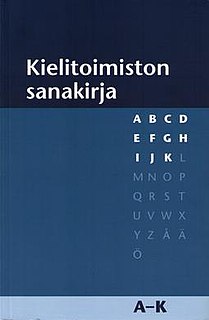 W
WFinnish is a Uralic language of the Finnic branch spoken by the majority of the population in Finland and by ethnic Finns outside Finland. Finnish is one of the two official languages of Finland. In Sweden, both Finnish and Meänkieli are official minority languages. The Kven language, which like Meänkieli is mutually intelligible with Finnish, is spoken in the Norwegian county Troms og Finnmark by a minority group of Finnish descent.
 W
WDictionary of Contemporary Finnish is the most recent dictionary of the modern Finnish language. It is edited by the Institute for the Languages of Finland. The current printed edition was first published in 2006 and is based on the 2004 digital version of the same name. The printed version lacks some features of the electronic version, such as the latter's index of Finnish place names (asuinpaikkahakemisto).
 W
WFinnicization is the changing of one's personal names from other languages into Finnish. During the era of National Romanticism in Finland, many people, especially Fennomans, finnicized their previously Swedish family names.
 W
WThe Finnish Cultural and Academic Institutes is a group of 17 independent, non-profit organisations around the world. The institutes advance and support international mobility, visibility and collaboration of Finnish professionals in the arts, culture and research.
 W
WThe Institute for the Languages of Finland is a governmental linguistic research institute of Finland geared at studies of Finnish, Swedish, the Sami languages, Romani language, and the Finnish Sign Language.
 W
WThe Institute for the Languages of Finland is a governmental linguistic research institute of Finland geared at studies of Finnish, Swedish, the Sami languages, Romani language, and the Finnish Sign Language.
 W
WKarelian is a Finnic language spoken mainly in the Russian Republic of Karelia. Linguistically, Karelian is closely related to the Finnish dialects spoken in eastern Finland, and some Finnish linguists have even classified Karelian as a dialect of Finnish, though in the modern day it is widely considered a separate language. Karelian is not to be confused with the Southeastern dialects of Finnish, sometimes referred to as karjalaismurteet in Finland.
 W
WThere are 53 municipalities of Finland in which Finnish is not the sole official language. In Finland, as of December 31, 2013, 89.3% of the population speak Finnish, 5.3% Swedish and 0.04% Sami languages. Both Finnish and Swedish are official languages of Finland. Officially, a municipality is bilingual if the minority language group consists of at least 8% of the population, or at least 3,000 speakers. A previously bilingual municipality remains so if the linguistic minority proportion drops below 8%, up to 6%. If it drops below 6%, it is possible for the municipality to remain bilingual by government decree, on the recommendation of the municipal council, for a further ten years. Municipalities that make use of the 3,000-speaker rule include the national capital Helsinki and the cultural center of Swedish Finns, Turku. On the Åland archipelago, where Finnish is almost absent from daily life, the language law does not apply. On the mainland, the highest proportion of Swedish-speakers is found on the western coast, in Ostrobothnia.
 W
WSe Wsi Testamenti is the first translation of the New Testament in Finnish; it was published in 1548. It was translated by Mikael Agricola, then rector of the Turku Cathedral School and later Bishop of Turku.